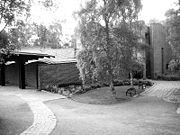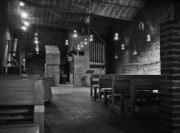
Sigurd Lewerentz
Encyclopedia



Architect
An architect is a person trained in the planning, design and oversight of the construction of buildings. To practice architecture means to offer or render services in connection with the design and construction of a building, or group of buildings and the space within the site surrounding the...
, but initially trained as a mechanical engineer at the Chalmers University of Technology
Chalmers University of Technology
Chalmers University of Technology , is a Swedish university located in Gothenburg that focuses on research and education in technology, natural science and architecture.-History:...
in Gothenburg
Gothenburg
Gothenburg is the second-largest city in Sweden and the fifth-largest in the Nordic countries. Situated on the west coast of Sweden, the city proper has a population of 519,399, with 549,839 in the urban area and total of 937,015 inhabitants in the metropolitan area...
(1905–8). Later he took up an architectural apprenticeship in Germany
Germany
Germany , officially the Federal Republic of Germany , is a federal parliamentary republic in Europe. The country consists of 16 states while the capital and largest city is Berlin. Germany covers an area of 357,021 km2 and has a largely temperate seasonal climate...
. He first opened his own office in Stockholm
Stockholm
Stockholm is the capital and the largest city of Sweden and constitutes the most populated urban area in Scandinavia. Stockholm is the most populous city in Sweden, with a population of 851,155 in the municipality , 1.37 million in the urban area , and around 2.1 million in the metropolitan area...
in 1911, and through his association with Gunnar Asplund
Gunnar Asplund
Erik Gunnar Asplund was a Swedish architect, mostly known as a key representative of Nordic Classicism of the 1920s, and during the last decade of his life as a major proponent of the modernist style which made its breakthrough in Sweden at the Stockholm International Exhibition...
became involved with the design of cemetery.
Together they made a winning entry for the Stockholm South (Woodland) Cemetery
Skogskyrkogården
Skogskyrkogården is a cemetery located in the Enskededalen district south of central Stockholm, Sweden...
competition of 1914–15. This project was implemented initially by both architects, however, the latter stages were done by Asplund alone. He and Asplund were appointed as the main architects for the Stockholm International Exhibition (1930)
Stockholm International Exhibition (1930)
The Stockholm Exhibition was an exhibition held in 1930 in Stockholm, Sweden, that had a great impact on the architectural styles known as Functionalism and International Style....
but afterwards Lewerentz became disillusioned, Lewerentz turned away from architecture for many years, and from 1940 he ran a factory producing windows and other architectural fittings of his own design.
Sigurd Lewerentz, together with his colleagues Erik Lallerstedt and David Helldén, created what is regarded of one of the masterpieces of functionalist architecture, Malmö Opera and Music Theatre
Malmö Opera and Music Theatre
Malmö Opera and Music Theatre is an opera house in Malmö, Sweden. An opera company of the same name presents seasons of opera in this house....
. The foyer is considered of particular beauty, with its open surfaces and beautiful marble staircases and it is adorned with a number of works of art by artists such as Carl Milles
Carl Milles
Carl Milles was a Swedish sculptor, best known for his fountains. He was married to artist Olga Milles and brother to Ruth Milles and half brother to the architect Evert Milles...
and Isaac Grünewald
Isaac Grünewald
Isaac Grünewald was a Swedish-Jewish expressionist painter born in Stockholm. He was the leading and central name in the first generation of Swedish modernists from 1910 up until his death in 1946, in other words during almost his entire career spanning four decades...
.
In the last decade of his life he designed two churches, St. Mark's, Björkhagen
Björkhagen
Björkhagen is a district in Skarpnäck borough, Stockholm, Sweden. Björkhagen has 5,695 inhabitants as of December 31, 2007.The Stockholm Metro station Björkhagen is an elevated station which is serviced by the green line 17.-References:...
, Stockholm (1956) and St. Peter's, Klippan
Klippan Municipality
Klippan Municipality is a municipality in Skåne County in southern Sweden. Its seat is located in the town of Klippan.The municipality was created in 1974 through the amalgamation of the market town Klippan with the rural municipality of Riseberga and part of Östra Ljungby.Söderåsen National Park...
(1963), that revived his career in architecture. He continued to work at competition proposals and furniture designs until shortly before his death.

